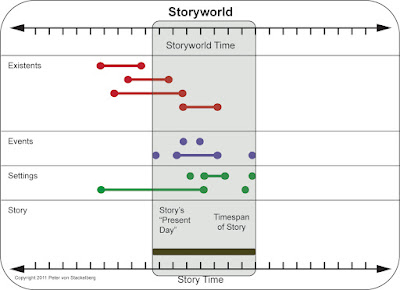Ryan notes that events provide a temporal dimension by creating a history of the changes that occur in the time span framed by the universe (Ryan, 2011). This temporal dimension allows for the development of dynamic storyworlds rather than static text worlds. A disadvantage, however, is that if every sequence of events generates a different storyworld it is difficult to create multiple stories within the same storyworld (Ryan, 2011).
A more flexible way to deal with the temporal dimension is to have an inherent property of the storyworld and by extension the existents, events, settings, and stories that are contained within that storyworld. This temporal dimension can be identified as storyworld time (see Figure 1). The use of the temporal dimension is a key method for organizing information and a timeline can be a powerful tool for organizing the various elements of the storyworld. Existents, events, and settings can be placed into the storyworld at the appropriate point on its timeline (see Figure 1).
Source: Peter von Stackelberg
Figure 1: The storyworld consists of existents (characters and significant objects), events, and settings that exist at points in storyworld time.
The time dimension can be stretched as much as needed to accommodate these elements. A story can be established with its own timeline – story time -- within storyworld time (see Figure 2). The “present day” of the story is established when the main part of the story begins. Prologues typically present a portion of the narrative that precedes the “present day” and is “outside” of the story.
Selecting from among the existents, events, and settings of the storyworld within the timeframe of a story (see Figure 2) provides the basic elements from which to create the story.
Source: Peter von Stackelberg
Figure 2: A story establishes a timeline within storyworld time, with the story's "present day" typically occuring when the story starts.
Selecting a different set of existents, events, and settings provides the elements for a different story, even if the same timeframe is used (see Figure 5). Shifting the story timeframe results in a different set of existents, events, and settings being available and the emergence of a different story (see Figure 5).
Source: Peter von Stackelberg
Figure 3: A number of existents, events, and settings are selected from the storyworld to use in the story.
Source: Peter von Stackelberg
Figure 4: A different combination of existents, events, and settings selected from the storyworld produces a different story, even if the time span of the story is identical to another one.
Source: Peter von Stackelberg
Figure 5: Using a different timeframe for a story results in a different story with different existents, events, and settings.





ReplyDeleteThanks for posting such a Useful information .You done a great job.
Selenium Training in Chennai | Certification | Online Courses
selenium training in chennai
selenium training in chennai
selenium online training in chennai
selenium training in bangalore
selenium training in hyderabad
selenium training in coimbatore
selenium online training
As a former user of Wickr, if someone asked me to recommend an encrypted IM app I'd honestly tell them "use absolutely anything but Wickr". It .Wickr Me Mod Apk
ReplyDelete